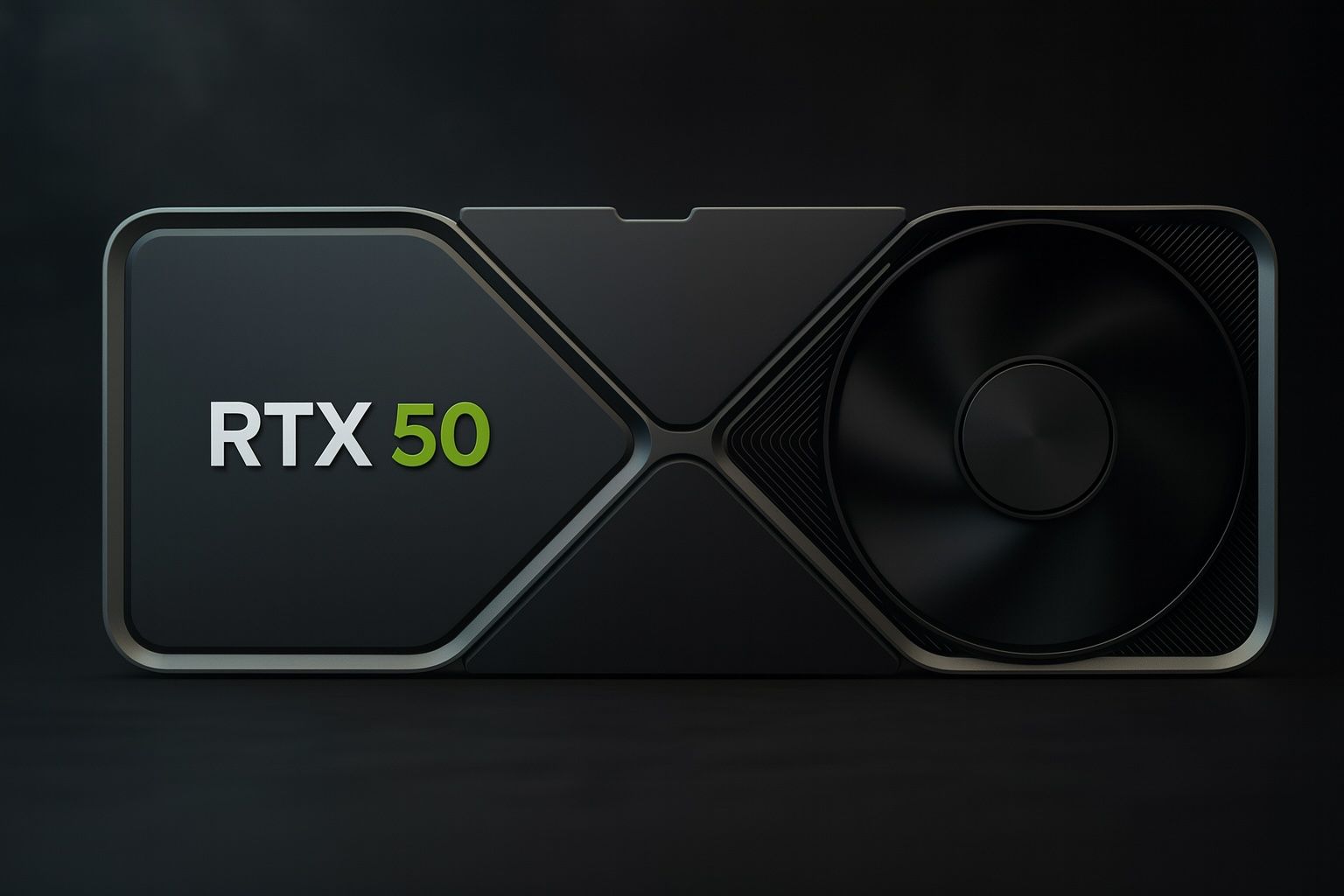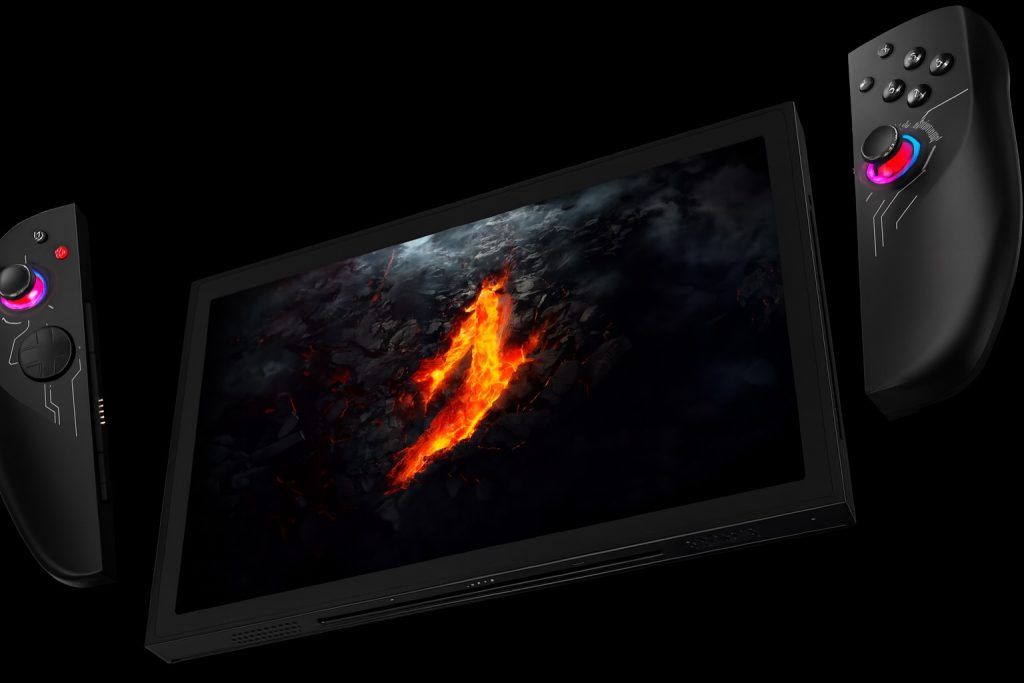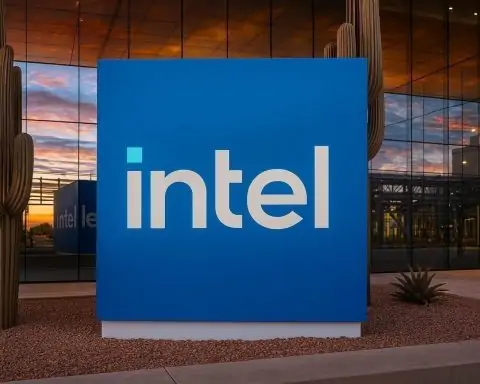- Official 2025 Launch – Nvidia revealed the GeForce RTX 50-series (codename Blackwell) at CES 2025, headlined by the $1,999 RTX 5090 and $999 RTX 5080 GPUs (available January 30, 2025) Theverge. The lineup scaled down through a $749 RTX 5070 Ti and $549 RTX 5070 in February, all the way to a $299 RTX 5060 (May 19) and $249 RTX 5050 (July 1) by mid-2025 Digitaltrends.
- Next-Gen Blackwell Architecture – Built on TSMC’s 4nm process, Blackwell GPUs introduce massive hardware upgrades. The RTX 5090 boasts 21,760 CUDA cores and 32GB of new GDDR7 memory on a radical dual-slot PCB design Nvidia. Nvidia even redesigned the board with a 30-phase VRM and liquid metal cooling to tame the 575W flagship card Theverge Digitaltrends. All RTX 50 cards use faster GDDR7 VRAM and support PCIe 5.0 and DisplayPort 2.1 for up to 8K/165Hz output Theverge.
- AI-Powered DLSS 4 & Frame Generation – Deep Learning Super Sampling 4 is the 50-series’ secret sauce. Its new Multi Frame Generation (MFG) leverages 5th-gen Tensor Cores to generate 3 extra frames for every 1 rendered, potentially boosting frame rates up to 8× over traditional rendering Digitaltrends Digitaltrends. NVIDIA claims this “neural rendering” lets the $549 RTX 5070 deliver RTX 4090-class performance via AI Theverge Digitaltrends. In Jensen Huang’s words, “the future of computer graphics is neural rendering” Digitaltrends.
- Performance vs Previous Gen – Nvidia advertised 2× performance gains over RTX 40-series in best-case scenarios with DLSS 4 Theverge. Indeed, demos showed an RTX 5090 hitting ~238 FPS in Cyberpunk 2077 (path-traced) with DLSS 4, versus ~106 FPS on an RTX 4090 with DLSS 3.5 Theverge. However, independent benchmarks paint a more tempered picture: the RTX 5090 is about 30% faster than the 4090 at 4K resolution when using traditional rendering (no frame generation) Digitaltrends – a big leap, but not a doubling of raw raster performance.
- Pricing & Market Reception – The RTX 50-family spans $249 to $1,999 MSRP Digitaltrends, with midrange models actually launching cheaper than their RTX 40-series predecessors (the 5070 Ti/5070 came in $50 below last-gen’s 4070 Ti/4070) Digitaltrends. At the top end, though, the RTX 5090’s $1,999 tag is $400 higher than the 4090’s launch price Digitaltrends, raising eyebrows. Early demand and limited supply drove street prices even higher (the RTX 5090 initially sold for ~$2,399, ~20% over MSRP) Digitaltrends, though lesser models have largely stayed at or below list price. AMD’s competing Radeon RX 9000 series (RDNA 4) began rolling out in 2025 with cards like the $549 RX 9070, aiming to challenge Nvidia’s midrange Tomshardware – but Nvidia still holds the uncontested performance crown at the ultra-high end this generation.
Overview: A New Generation of GeForce GPUs
Nvidia’s GeForce RTX 50-series represents a major generational leap in consumer GPUs, blending unprecedented raw performance with AI-driven features. Officially unveiled by CEO Jensen Huang during the CES 2025 keynote, the RTX 50 line is built on the new “Blackwell” architecture – named after mathematician David Blackwell – and succeeds the RTX 40-series (Ada Lovelace) after roughly two years Theverge Digitaltrends. The launch introduced four desktop cards initially (RTX 5090, 5080, 5070 Ti, 5070) with additional models following in the subsequent months Theverge Digitaltrends. Nvidia also rolled out RTX 50-series mobile GPUs for laptops starting in March 2025, bringing the Blackwell architecture’s benefits to gaming notebooks Theverge.
The goal of the RTX 50-series is clear: push the envelope of real-time graphics and computing power, especially through advanced AI technologies. Nvidia is touting up to double the performance of last-gen cards in games and creative apps by leveraging new AI features like DLSS 4 and RTX Neural Shaders, rather than brute-force hardware alone Theverge Digitaltrends. At the same time, the lineup addresses some past generation pain points – for example, despite drawing more power, the flagship RTX 5090 comes in a much smaller form factor than the bulky RTX 4090, thanks to an overhauled board and cooling design Theverge. Below, we break down the key features, specs, performance metrics, and market context of Nvidia’s RTX 50-series now that it’s officially available in 2025.
Pricing and Launch Timeline
Nvidia launched the RTX 50-series aggressively over the first half of 2025. The top-tier GeForce RTX 5090 and RTX 5080 hit store shelves on January 30, 2025 Theverge, just weeks after their CES debut. The RTX 5090 debuted at an MSRP of $1,999 while the 16GB RTX 5080 was set at $999 – matching the 4080’s launch price Theverge Digitaltrends. In February, Nvidia followed up with the RTX 5070 Ti ($749) and RTX 5070 ($549) Theverge. Mainstream and budget models rolled out in spring and summer: a RTX 5060 Ti (in both 16GB $429 and 8GB $379 variants) launched in April, the RTX 5060 ($299) in May, and finally an entry-level RTX 5050 ($249) on July 1, 2025 Digitaltrends. This rapid release cadence meant that, by mid-2025, Nvidia’s entire next-gen desktop lineup from $250 up to $2000 was on the market.
Reception to Nvidia’s pricing was mixed. On one hand, the midrange RTX 5070 Ti/5070 came in slightly cheaper than their 40-series predecessors (each $50 below the 4070 Ti and 4070’s launch prices) Digitaltrends, and the 5060 stayed at a budget-friendly $299. On the other hand, the halo-class RTX 5090 shocked enthusiasts with a $1,999 MSRP – $400 higher than the RTX 4090’s debut price of $1,599 Digitaltrends, which itself was a record-setter. This steep increase at the top end drew some criticism and “eyebrow-raising” from the community Digitaltrends. Nvidia argued the price hike is commensurate with the 5090’s leap in capabilities, but it nonetheless marked a new high for consumer GPU pricing.
Availability in the months after launch has been a mixed bag. Demand for the flagship models was enormous, leading to shortages and scalping. The RTX 5090 in particular was “impossibly hard to get” at launch according to some retailers Digitaltrends, and actual street prices soared well above MSRP. By August 2025, the 5090 was typically selling around $2,300–$2,400 (roughly 15–20% over list price) Digitaltrends. The RTX 5080 also saw a smaller markup (~$1,099, about $100 over MSRP) Digitaltrends. In contrast, lower-tier 50-series cards have been easier to find: the RTX 5070 has been available at its $549 sticker price Digitaltrends, and some models like the 8GB 5060 Ti even dipped below MSRP during sales Digitaltrends. This divergence is typical – early adopters chasing the highest-end card pay a premium, while mainstream GPUs face more competition and supply. Overall, the GPU market in 2025 remains turbulent (with generally inflated prices), though it’s gradually stabilizing compared to the chaos of a few years ago Digitaltrends.
Looking ahead, Nvidia’s pricing strategy may also be influenced by competition. AMD has started launching its own next-gen GPUs – the Radeon RX 9000-series based on RDNA 4 – in a bid to undercut Nvidia’s value proposition. Notably, AMD’s first RDNA4 cards, the Radeon RX 9070 XT ($599) and RX 9070 ($549), arrived in March 2025 Tomshardware squarely targeting the same price segment as Nvidia’s RTX 5070 Ti/5070. This suggests a brewing midrange battle. However, AMD did not immediately release a “RX 9090” equivalent to challenge the RTX 5090 at the ultra-enthusiast tier, leaving Nvidia with basically no direct competitor for the performance crown in early 2025. Industry analysts note that Nvidia’s swift roll-out of the full 50-series lineup has kept it a step ahead of AMD’s schedule Tomshardware Tomshardware. Intel, meanwhile, is expected to launch its Arc “Battlemage” GPU lineup in 2025 as well Tomshardware, but those are anticipated to compete in midrange segments; Intel still lacks a high-end GPU to rival GeForce or Radeon flagships.
Blackwell Architecture & New Features
At the heart of the RTX 50-series is Blackwell, Nvidia’s latest GPU architecture succeeding Ada Lovelace. Blackwell is manufactured on TSMC’s refined 4nm node (called 4NP) Digitaltrends, allowing Nvidia to pack more transistors and achieve higher clocks at similar or lower power per transistor. In fact, the flagship RTX 5090 chip (codenamed GB202) contains a staggering ~92 billion transistors, a major jump from the ~76 billion in the RTX 4090 (Ada) Digitaltrends. To support this density and the card’s hefty power draw, Nvidia completely redesigned the PCB (printed circuit board) of its Founders Edition cards. The RTX 5090’s board is split into three sections, with a main board holding the GPU die, 32GB of GDDR7 memory, and a massive 30-phase VRM power array Digitaltrends. The remaining sections (which Nvidia kept under wraps initially) integrate the PCIe connector, display outputs, and cooling/fan power – a novel modular approach to PCB design Digitaltrends. This creative board layout, along with other optimizations, enabled something remarkable: despite its deuces power, the RTX 5090 shrinks back to a 2-slot thickness, making it much smaller than the notoriously huge 3-slot RTX 4090 Theverge. It’s a notable feat of engineering that a card pushing 575W can fit in many standard cases without the extreme bulk of its predecessor.
Cooling and construction got major upgrades as well. Nvidia introduced a new dual-fan “flow-through” cooler design for 50-series Founders Edition cards Theverge. The heatsink now includes a 3D vapor chamber for more efficient heat spread, and Nvidia even swapped traditional thermal paste for a liquid metal TIM (thermal interface material) on the RTX 5090 to improve heat transfer from the die Digitaltrends. These changes help tame the higher TGP (total graphics power) of Blackwell GPUs. Additionally, all RTX 50 cards are the first to feature GDDR7 memory, which runs faster and cooler than the GDDR6X of the 40-series. For example, the RTX 5090’s 32GB of GDDR7 operates at 28 Gbps, delivering a whopping 1,792 GB/s of memory bandwidth over a widened 512-bit bus Nvidia. Even the RTX 5080 uses 16GB of GDDR7 at 30 Gbps (on a 256-bit bus) for 960 GB/s bandwidth Theverge. This transition to GDDR7 across the lineup boosts memory throughput for high-resolution textures and ray-tracing data.
In terms of core counts and specs, the Blackwell SM (Streaming Multiprocessor) architecture brings generational gains. The RTX 5090 packs 170 SMs (versus 128 on the 4090) – a ~33% increase in CUDA cores (21,760 vs. 16,384) to drive shader and compute workloads Nvidia. Nvidia also outfitted each SM with upgraded 5th-generation Tensor Cores and 4th-generation RT Cores. In the 5090, there are 680 Tensor Cores and 170 RT Cores in total Nvidia, enabling improved AI and ray tracing performance. These Tensor Cores are significantly beefier – Nvidia says they deliver up to 2.5× the AI compute throughput of the previous generation’s (Lovelace) Tensor units Digitaltrends. Likewise, the new RT Cores improve ray-triangle intersection speed and BVH traversal, though Nvidia hasn’t quoted a specific x-factor for ray tracing beyond showing that Blackwell GPUs can handle path-traced gaming at higher fps (thanks in part to DLSS 4). Another futuristic addition is support for Optical Flow Accelerator 2.0 – interestingly, Nvidia replaced the dedicated optical flow hardware (used for generating interpolation data in DLSS 3) with an AI-based solution in Blackwell Digitaltrends. This indicates Nvidia is leaning even more on AI algorithms to handle tasks that used to have fixed-function hardware.
One more new feature unique to the 50-series is RTX Neural Shaders. Nvidia describes these as bringing AI enhancements to the traditional shader pipeline Digitaltrends. In practice, Neural Shaders can use AI models to optimize or enhance certain rendering steps – for example, improving lighting quality, texture detail, or upscaling pixels in ways conventional shaders can’t. These neural shaders run on the Tensor Cores and are part of Nvidia’s broader neural rendering push (which also includes DLSS 4’s frame generation, discussed below). While it will be up to game developers to implement support, the promise is that RTX 50 GPUs can apply AI on the fly to make games look better or run more efficiently, beyond what raw horsepower alone would achieve.
Aside from core architecture, the RTX 50-series comes fully loaded with modern I/O and display capabilities. The cards are PCI Express 5.0 compliant (doubling the interface bandwidth of RTX 40’s PCIe 4.0, though in real-world gaming this has minimal impact so far). More tangibly, they upgrade to DisplayPort 2.1 (specifically DP 2.1a/2.1b depending on model) outputs Theverge, which support ultra-high resolutions and refresh rates – up to 8K at 165 Hz or 4K at 480+ Hz with DSC. This is a future-proofing step for next-gen monitors (the 40-series was limited to DP 1.4a, max 8K/60 or 4K/240 without compression). HDMI 2.1 ports are also present for 4K/120 and beyond on TVs. The upshot is that RTX 50 GPUs are ready for the latest displays and won’t be the bottleneck in pushing extreme resolution/refresh combinations, at least on the connectivity side.
DLSS 4: Pushing Frames with AI
The marquee feature of the RTX 50 generation is undoubtedly DLSS 4, the latest evolution of Nvidia’s AI super sampling and frame generation tech. DLSS (Deep Learning Super Sampling) has been a game-changer since its introduction, using neural networks on the GPU’s Tensor Cores to upscale lower-res images to high-res with minimal quality loss. DLSS 3, featured in the RTX 40-series, added the ability to generate entirely new frames (Frame Generation) to boost frame rates. Now, DLSS 4 takes things to a whole new level with what Nvidia calls Multi Frame Generation (MFG) Digitaltrends.
Multi Frame Generation allows the GPU to generate up to 3 additional AI frames for every 1 traditional frame rendered Digitaltrends. In other words, where DLSS 3 generated one interpolated frame for each real frame (doubling the frame rate), DLSS 4 can quadruple it. Nvidia asserts that by combining MFG with all of DLSS 4’s upscaling and AI anti-aliasing techniques, games can see up to 8× higher FPS compared to native rendering Digitaltrends. For instance, Nvidia showed the RTX 5090 hitting ~240 FPS at 4K with full ray tracing in Cyberpunk 2077 using DLSS 4’s frame generation – an astonishing result, considering without DLSS the game struggled to reach ~30 FPS at those settings Digitaltrends Digitaltrends. This kind of leap is only possible because DLSS 4 generates 15 out of every 16 pixels via AI, as Jensen Huang explained – the GPU is only conventionally rendering a small fraction of the final output Digitaltrends.
To achieve this, DLSS 4 leverages upgraded hardware and AI models on the RTX 50 cards. The 5th-gen Tensor Cores are critical: they provide the horsepower to run the more advanced DLSS 4 algorithms, which Nvidia says are 40% faster and 30% less memory-intensive than the prior version Digitaltrends. Notably, Nvidia eliminated the optical flow accelerator hardware in Blackwell; instead, the motion vector predictions for frame gen are handled by a new AI optical flow model, which presumably offers better accuracy or performance Digitaltrends. There’s also mention of new “Flip Metering” hardware in the GPU that helps synchronize the output of generated frames to the display to reduce jitter Digitaltrends. The result is a smoother frame pacing even when multiple frames are being synthesized per input.
In practical terms, what does DLSS 4 mean for gamers? It means that even in extremely demanding scenarios (like path-traced lighting at 4K), an RTX 50-series card can produce silky high frame rates that were previously unthinkable on a single GPU. However, there are some caveats. First, frame generation doesn’t come for free – while it massively boosts fps, it doesn’t increase the rate of game simulation or input sampling. For example, in the Cyberpunk demo, the RTX 5090 was outputting 239 FPS with MFG, but player input was still only sampled at ~34 FPS (the “true” underlying frame rate) Tomshardware Tomshardware. Gamers generally report that the experience feels smoother than 34 FPS, but not as perfectly fluid as a native 239 FPS, because the responsiveness lags behind the visual frames Tomshardware. In short, DLSS 4 greatly improves perceived smoothness, but it can’t fully eliminate the latency constraints of a low base frame rate.
Secondly, image quality can be a mixed bag in early DLSS 4 titles. In our own testing, Digital Trends noted that enabling 4× frame generation in Cyberpunk 2077, while delivering a huge performance jump (from unplayable to 239 fps), introduced some visual artifacts – e.g. instances of motion blur and unnatural-looking objects during fast action Digitaltrends Digitaltrends. That particular game, with a native ~30 FPS, seemed to trip up the AI more. By contrast, other games where the base frame rate was higher benefited more cleanly: Marvel’s Spider-Man (as seen in the Marvel’s Spider-Man 2 – “Rivals” demo) and Alan Wake 2 both showed smooth, artifact-minimal results with DLSS 4, according to hands-on reports Digitaltrends Digitaltrends. It appears that DLSS 4 works best when the original frame rate isn’t too low – the AI has an easier time “predicting the future” (to use Jensen’s phrase) when motion between frames is smaller. Nvidia is continually refining the DLSS models to reduce ghosting and weird artifacts, using techniques like transformer-based AI improvements for better image quality in motion Theverge Theverge.
Another consideration is that DLSS 4’s benefits are partly restricted to RTX 50-series hardware. The upscaling and anti-aliasing improvements of DLSS 4 (e.g. using higher quality AI models for detail reconstruction) have been made compatible with older RTX GPUs as well Digitaltrends. But the headline feature – Multi Frame Generation – is exclusive to the 50-series (at least officially), likely because it relies on the 5th-gen Tensor cores and other hardware present only in Blackwell GPUs Digitaltrends. This means only RTX 50 owners get to enjoy the full 4× frame-gen boost. The good news is that adoption of DLSS 4 has been swift: at launch it was supported in 75 games, and by now (late August 2025) over 125 games have implemented the multi-frame generation feature Digitaltrends. We can expect that number to keep growing, much as DLSS 3 became widely supported in the couple of years after its introduction.
In summary, DLSS 4 represents Nvidia’s continuing bet on AI as the future of graphics. It dramatically raises performance ceilings for those edge cases where pure hardware brute force isn’t enough, enabling new levels of fidelity (like path tracing) at high resolutions. While it’s not magic – you may still catch the occasional artifact or feel slight input lag differences – it’s undeniably one of the key selling points of the RTX 50-series. Nvidia’s Huang even framed the generation’s value in these terms: rather than purely counting traditional FPS, the 50-series’ prowess is that “most of the pixels are generated” by AI Digitaltrends, offloading work from the raster pipeline. Time will tell how developers utilize these neural rendering capabilities, but it’s a fascinating shift where software and silicon advances are intertwined to deliver gaming performance.
Real-World Performance Benchmarks
Marketing claims aside, how do the RTX 50-series cards actually perform in the real world? After months of reviews and testing, we have a clearer picture of the true performance uplift over last generation – and it’s impressive, though not always as extreme as Nvidia’s on-stage claims with DLSS 4 included.
Starting at the top, the GeForce RTX 5090 is without question the fastest consumer GPU ever released as of 2025. Across a suite of 4K gaming benchmarks (rasterized, no frame generation), the RTX 5090 has been measured around 30% faster on average than the RTX 4090 Digitaltrends. This is a significant generational jump, albeit short of the “2× performance” figure Nvidia quoted (which, as noted, was achieved using DLSS 4). In certain titles, the 5090’s advantage is even bigger – for example, in Cyberpunk 2077 (with ultra settings, no DLSS), reviewers saw the 5090 pull about 54% ahead of the 4090 Digitaltrends, breaking the 100 FPS barrier where the 4090 could not. Similarly, very GPU-heavy games like Dying Light 2 or Horizon Zero Dawn: Remastered show substantial gains well above 40–50% in favor of the new flagship Digitaltrends. However, in less demanding or engine-limited games, the gap narrows: for instance, Assassin’s Creed Mirage only ran ~17% faster on the 5090 than on the 4090 Digitaltrends, likely because the game (or CPU) becomes a bottleneck before the GPU is fully taxed. On average, a 20–40% boost at 4K resolution is a good rule of thumb for the 5090 over its predecessor in traditional rendering tasks.
When you introduce DLSS 4 frame generation into the mix, the performance picture changes – often dramatically. With frame gen enabled, the RTX 5090 can indeed produce frame rates far beyond what the 4090 can achieve without it. The earlier example of 239 FPS vs 106 FPS in Cyberpunk (DLSS 4 vs DLSS 3.5) highlights how much potential uplift is on tap Theverge. But since DLSS 4 is a unique advantage of the 50-series, this isn’t a direct apples-to-apples “GPU muscle” comparison – it’s more like a bonus for 50-series owners. If one compares 5090 with DLSS 4 vs 4090 with DLSS 3, you’ll often see 1.5× to 2× higher frame rates in supported games. Yet, as discussed, those extra frames come via AI. Crucially, even without counting AI-augmented performance, the RTX 5090 does outclass the 4090 convincingly in raw horsepower, just not by double. In fact, the generational gain from 4090 → 5090 (~30%) is smaller than 3090 → 4090 was (~70–80%) Digitaltrends Digitaltrends. This indicates Nvidia might be hitting diminishing returns at the very high end or allocating more of the silicon budget to AI features rather than pure rasterization.
The story for the RTX 5080 is a bit more nuanced. Nvidia pitched the 16GB RTX 5080 as delivering roughly 2× the performance of the RTX 4080 (which had 16GB GDDR6X) Theverge. In reality, early tests suggest the 5080 is a more modest upgrade over the 4080 – one reviewer noted it delivers only “slightly better performance” than a hypothetical 4080 “Super” variant Tomshardware. (Nvidia never released an RTX 4080 Super, but the 4080 itself and any overclocked editions set the bar.) The RTX 5080 features 10,752 CUDA cores and 16GB GDDR7 on a 256-bit bus Theverge, compared to 9,728 cores and 16GB GDDR6X on the 4080. That’s about a 10% increase in core count, plus faster memory and architecture improvements. In practice, benchmarks have shown the 5080 tends to be 20%–30% faster than a 4080 in raster performance, and perhaps a bit more in ray tracing due to the new architecture. It’s a healthy jump, but not transformational. Notably, the power draw for the RTX 5080 is rated at 360W (Nvidia recommends an 850W PSU) Theverge, which is slightly higher than the 320W of the 4080. The increase in performance per watt is there, but the 5080 doesn’t break new efficiency records; rather, it uses somewhat more power to achieve higher frames. Some early adopters and reviewers have pointed out that the value proposition of the 5080 at $999 feels underwhelming if you already own a 4080 – the gains might not justify a full upgrade, especially when the 4090 (now often found near $1600) still outperforms the 5080 by a large margin.
The mid-range RTX 5070 Ti and RTX 5070 are where things get very interesting. Nvidia claimed the RTX 5070 Ti is 2× faster than the RTX 4070 Ti, and that the RTX 5070 can match an RTX 4090’s performance (with the aid of DLSS 4) Theverge. These claims understandably generated both excitement and skepticism. In practice, the RTX 5070 Ti (16GB, 8960 CUDA cores, 300W) and RTX 5070 (12GB, 6144 cores, 250W) Theverge do offer huge gen-on-gen jumps – roughly ~70–80% faster than the 4070 Ti and 4070 in many games, when frame generation is enabled. Without frame gen, they’re more in the range of 30–50% faster in raw raster, according to leaked benchmarks. The RTX 5070 in particular garnered attention because at $549, Nvidia positioned it as a “RTX 4090 for the masses.” Jensen Huang even bragged on stage that RTX 4090-level performance could be had for a third of the cost, thanks to the magic of DLSS 4 Theverge. It turns out this was a bit hyperbolic – no, the 5070 will not output 4090-class frame rates in pure rasterization. But with generous help from AI frame generation, it can indeed produce similar frame rates to a 4090 in certain scenarios. For example, in a DLSS 4-enabled title, a 5070 running MFG might rival a 4090 running without it (or with older DLSS). This has sparked debate in the community about AI-augmented performance vs “true” performance. Regardless, the 5070 is a very strong card for the money, and importantly Nvidia gave it a healthy 12GB VRAM, addressing criticism that the 12GB 4070 was borderline for high-end 1440p/4K gaming longevity.
Rounding out the lineup, the RTX 5060 Ti and RTX 5060 target the 1080p to 1440p gamers on tighter budgets. The RTX 5060 Ti comes in two memory configurations – 16GB and 8GB – which is a new strategy by Nvidia to offer a choice between VRAM and price. The 16GB model at $429 caters to those who want extra memory headroom (perhaps for certain games or creative work), while the 8GB model at $379 is there for pure gamers who can save $50. Both have the same core counts and ~180W TGP Digitaltrends Digitaltrends. These 5060 Ti cards handily beat the previous RTX 4060 Ti (8GB) which was often criticized for limited VRAM and marginal gains over the RTX 3060 Ti. Reviews indicate the 5060 Ti 16GB can outperform a 4060 Ti by ~35% and even edge past the old RTX 3080 in some tests, thanks to Blackwell efficiencies and DLSS 4 support. Meanwhile, the vanilla RTX 5060 8GB (145W) slots in at $299 Digitaltrends, essentially taking the place of what the xx60 class traditionally offers: high settings 1080p gaming and decent 1440p with DLSS. Nvidia’s focus on AI means even this entry-mainstream card supports DLSS 4, so in supported titles the 5060 can punch above its weight class – though it’s also more limited by its narrower 128-bit bus and 8GB memory in heavy workloads.
One thing to mention is power and efficiency. Across the board, RTX 50-series GPUs have higher TGPs than their 40-series counterparts. The 5090’s 575W is a big uptick from the 4090’s 450W Theverge, the 5080’s 360W is slightly above the 4080’s 320W, the 5070 Ti’s 300W exceeds the 285W of the 4070 Ti, and so on Theverge. Nvidia did this to maximize performance, but they also leveraged architectural improvements to ensure that performance-per-watt still improved in many scenarios. In non-AI tasks, Blackwell GPUs appear to be only modestly more power-efficient than Ada (since a lot of the die is dedicated to AI logic now), whereas in AI-heavy tasks or DLSS, the efficiency gains are huge. The real-world effect is that system builders need to be mindful of power and cooling when adopting a 50-series card, especially the higher end. Nvidia’s recommendation of a 1000W PSU for the 5090 Theverge underscores that these are power-hungry beasts. Custom card manufacturers have responded with beefy coolers and sometimes even hybrid liquid cooling options on overclocked 5090s to handle the thermals. Still, thanks to the refined cooler design, the Founders Edition 5090 has been praised for keeping temperatures and noise in check (often under 80°C at full load and quieter than some partner cards).
Lastly, it’s worth noting CPU bottlenecks: As GPUs like the RTX 5090 push into extreme frame rate territories, especially at lower resolutions, they become limited by CPU performance. Tests show that at 1440p resolution, the 5090’s lead over the 4090 shrinks to ~22% on average Digitaltrends because many games become CPU-bound around 200+ FPS where these cards operate. At 1080p, even a top-flight CPU cannot fully feed the 5090, making it only ~10-15% faster than a 4090 in some cases Digitaltrends. This simply highlights that the full benefits of the RTX 50-series are realized at higher resolutions and in GPU-heavy scenarios (like 4K, ray tracing, or with frame gen). Gamers with high refresh 1440p monitors will still enjoy great performance, but the bottleneck shifts – a reminder that a balanced system is important.
Market Position and Competitive Landscape
With the RTX 50-series, Nvidia is cementing its dominance in the high-end graphics market – at least for now. By launching nearly the entire product stack in short order, Nvidia ensured that it had a fresh lineup against which competitors must play catch-up. As of August 2025, Nvidia leads in pure performance, owning the top spot with the RTX 5090 and strong showings across enthusiast and midrange tiers.
AMD’s response has been the rollout of its Radeon RX 9000-series GPUs based on the new RDNA 4 architecture. AMD actually previewed RDNA 4 at CES 2025 (the same event where Nvidia announced Blackwell) Tomshardware, but their launch has been more staggered. The first RDNA 4 cards (the RX 9070 XT and RX 9070) only hit the market in March 2025, targeting the $550–600 bracket Tomshardware. From pricing alone, it’s clear AMD aimed those at the heart of Nvidia’s lineup – the RTX 5070 and 5070 Ti. Indeed, early reviews suggest the RX 9070 series delivers competitive performance in that class, sometimes challenging the Nvidia cards in traditional raster benchmarks. However, Nvidia still holds some advantages: features like DLSS 4 frame generation currently have no direct equivalent on AMD (AMD’s upcoming FSR 4.0 might introduce similar frame-gen capabilities, but details are sparse). Moreover, Nvidia’s ray tracing performance has historically been better, and Blackwell’s improvements likely keep it ahead in ray-traced gaming versus RDNA 4 of similar class. Crucially, AMD has yet to release its flagship RDNA4 GPU. The hypothetical RX 9090 or whatever naming it takes hasn’t materialized by late 2025. This means the RTX 5090 remains in a league of its own; AMD’s top card from the previous generation, the Radeon RX 7900 XTX, can’t catch even the RTX 4080 in many cases, let alone the new 5090. In short, for enthusiasts who want the absolute fastest GPU, Nvidia faces effectively no competition at the moment – which perhaps gave it the confidence to set those ultra-high prices on the 5090.
That said, AMD is aggressively competing on value in the midrange. If cards like the RX 9060/9070 (rumored or launched) offer high performance per dollar, Nvidia may feel pressure to adjust pricing or release “SUPER” refreshes of the 50-series later to stay on top. It’s telling that Nvidia also ensured even its cheaper RTX 50 cards have features like DLSS 4, higher VRAM configurations, etc., which are selling points against AMD’s offerings. The competitive landscape in late 2025 seems to shape up as Nvidia owning the performance crown and feature lead (AI, ray tracing ecosystem), while AMD tries to undercut pricing and offer good enough performance for lower cost – a classic strategy.
Intel, the third player, is still early in its discrete GPU journey. Its first-gen Arc A-series (Alchemist) in 2022 made only a small dent, targeting budget segments. The second-gen Arc B-series (Battlemage) is anticipated sometime in 2025 Tomshardware, with rumors suggesting performance levels in the midrange (perhaps to rival ~RTX 4060/4070 class). Even if Intel delivers a solid product, it likely won’t threaten Nvidia’s high-end dominance this round. Intel is, however, relevant in pushing technologies like the new DirectX and Vulkan extensions for multi-frame generation (which could pave the way for industry-standard frame interpolation that works on all GPUs). Nvidia’s proprietary DLSS has the lead now, but competitors and open standards are being closely watched by the community.
From a market share perspective, Nvidia appears to be extending its lead in 2025. Industry reports indicate that in desktop GPU shipments, Nvidia climbed to around ~80%+ share, while AMD fell to historic lows (partly due to Nvidia’s strong RTX 40 sales and the slow RDNA4 rollout) Tomshardware. If Nvidia can meet the demand for RTX 50 cards and avoid the supply pitfalls of past launches, it’s poised to capture even more of the upgrade cycle. The RTX 4090 was already a surprise hit for an ultra-expensive GPU, and early signs show enthusiasts are adopting the RTX 5090 despite the $2k price tag (evidenced by it selling out and fetching $2.4k on the secondary market) Digitaltrends. Meanwhile, cards like the 5070 and 5060 will ensure Nvidia covers the volume segments, especially as production ramps and prices normalize.
One potential headwind is the general PC market climate – during 2022–2023, the GPU market was volatile (boom and bust in demand). By 2025, demand has stabilized but not grown dramatically, and many casual gamers are content with older GPUs or consoles. Nvidia’s heavy focus on AI features is also a bet that it can create new demand by enabling experiences (like full path tracing, high-frame-rate VR, AI-augmented creation) that were previously out of reach. So far, the strategy is working to differentiate GeForce from AMD’s offerings. Most tech analysts agree that the RTX 50-series puts Nvidia in a strong position going into the holiday 2025 season, with the only question being how and when AMD will strike back at the high end, and whether Nvidia might counter with mid-generation refreshes (there are already rumors of RTX 50 “SUPER” variants in late 2025 to fill any gaps Pcguide).
Early Reviews and Expert Commentary
The RTX 50-series launch has generated a ton of discussion among reviewers and industry experts. Overall, the consensus is that Nvidia has delivered powerhouse GPUs with cutting-edge features, but some of the marketing claims require context, and there have been a few early hiccups.
Many reviewers praise the incredible performance of cards like the RTX 5090, but also note that Nvidia’s “2× performance” slogan is largely tied to DLSS 4. As Digital Trends put it, “twice as fast was an overstatement” for raster performance – their tests showed about a 30% real-world uplift for the 5090 over the 4090 at 4K without frame generation Digitaltrends. This is still a sizable gain, just not the literal doubling that some might have expected from Nvidia’s presentation. The same review highlighted that while the 5090 can reach mind-boggling frame rates with DLSS 4, those numbers don’t always translate into a dramatically better experience in practice due to occasional artifacts and the limits of input lag Digitaltrends Digitaltrends. In short, the 50-series’ raw power is undeniable, but its biggest leaps come with the assist of AI.
Tech journalists have also commented on the value and positioning of certain models. The RTX 5080, for instance, received somewhat lukewarm reactions. Tom’s Hardware noted that the 5080 “delivers only slightly better performance” than the prior-gen 4080 Ti/Super-class card Tomshardware, implying that its $999 price feels steep for the gains offered. In contrast, the RTX 5070 Ti/5070 have been often lauded as the sweet spots of the lineup – providing 4080/4090-level gaming with features like DLSS 4 at a fraction of the cost, at least in supported games. Some experts caution that the 5070’s “4090 performance” claim is heavily dependent on enabling frame generation Theverge; without it, the 5070 is more like a very strong midrange card (which is exactly what it is). Still, the fact that a ~$500 GPU can even be mentioned in the same sentence as a $1600 flagship from last gen is a testament to how much Nvidia is leaning on AI enhancements to democratize performance.
There has also been discussion around the launch drivers and software maturity for the 50-series. Early adopters experienced a few teething issues – certain games didn’t recognize the new GPUs properly at first, and some users reported instability with MFG enabled in specific titles. Tom’s Hardware editor Jarred Walton remarked that Nvidia’s RTX 50-series drivers “haven’t had the smoothest of launches,” suggesting the initial driver package felt a bit half-baked Tomshardware. He noted that both the 5090 and 5080 seemed to need further driver optimizations, with the 5080 in particular underperforming expectations until updated drivers improved its standing. Nvidia was proactive in releasing hotfix drivers through February and March to iron out these kinks Digitaltrends. By April 2025, most early bugs (like idle power draw issues and DisplayPort quirks) were resolved, and performance in many games improved via driver updates. This isn’t unusual for a brand-new architecture – it often takes a month or two for drivers to fully optimize. The good news is Nvidia’s track record suggests they will continue to refine the 50-series through driver releases (and they’ve even introduced new metrics and tools for reviewers to better measure frame generation performance, like a new “MsBetweenDisplayChange” metric to complement the usual frame time metrics Tomshardware Tomshardware).
Another point of expert commentary is the power consumption and what it means for PC builders. While the RTX 4090 already pushed the envelope at ~450W, the 5090’s 575W has raised questions about power standards and connectors (though it still uses the same 16-pin 12VHPWR connector). Some PSU makers have released 1200W+ units anticipating overclocked 5090s. Reviewers found that in real gaming, the 5090 rarely hits the full 575W draw – it typically averages more in the 400–500W range unless under extreme stress tests Theverge Theverge. Nevertheless, the need for robust cooling is clear. Interestingly, despite these power needs, the community has been somewhat forgiving because Nvidia managed to keep noise and thermals reasonable with the new cooler design. Enthusiast outlets have done tear-downs of the 5090 FE and come away impressed by the engineering (the vapor chamber and liquid metal TIM really pay off in heat transfer). There is, however, an implicit arms race concern: can this power escalation continue? Or will Nvidia (and AMD) have to dial back and focus more on efficiency next round? Some analysts suspect this might be the peak before a retrenchment, especially given energy-conscious markets. But for now, the RTX 50-series unabashedly goes for maximum performance, power be damned.
Finally, we have Nvidia’s perspective and the broader vision. Jensen Huang and Nvidia’s spokespeople have emphasized that the RTX 50-series isn’t just about higher frame rates, but about enabling new experiences. They often highlight use cases like full real-time path tracing (e.g., in tech demos like Portal RTX or the upcoming Half-Life RTX) that simply were not playable on a single GPU before. With a 5090 and DLSS 4, those become viable at decent frame rates. Creative and AI workflows are another angle – the 50-series, with its beefed-up Tensor cores and larger memory, is pitched as not only a gamer’s dream but also a boon for content creators, 3D artists, and AI researchers on a budget. In Nvidia’s Studio documentation, they claim the RTX 5090 can double performance in 3D rendering and video editing tasks versus the 4090, especially when leveraging new AI features Nvidia. There’s also excitement about things like Nvidia Reflex 2 (which cuts latency further in esports games) and the new Nvidia ACE (Avatar Cloud Engine) integration for AI-driven NPCs – technologies that accompany the 50-series launch to showcase what all this GPU power can do beyond just higher FPS Nvidia Nvidia.
On the flip side, some veteran analysts point out that we’re entering an era of diminishing returns on pure graphics – that the visual leap from RTX 40 to 50 (outside of higher resolution or AI tricks) isn’t as jaw-dropping as, say, the leap from 2010-era to 2020-era graphics. They argue Nvidia is wisely pivoting to AI and software to create new value for its GPUs. The 50-series is the embodiment of that strategy: it’s as much about AI performance as it is about traditional GPU performance. For consumers, the takeaway from reviews is generally positive: if you want the best of the best, the RTX 50 cards deliver, and if you embrace features like DLSS 4, you can truly push the boundaries of today’s games. But if you’re purely interested in rasterized frame-per-dollar, the generational improvement – while solid – might not compel an upgrade at the very high end unless you’re a performance enthusiast or you skipped the 40-series entirely.
Conclusion
Nvidia’s GeForce RTX 50-series marks a new chapter in GPU technology, one where sheer hardware prowess merges with advanced AI algorithms to redefine what’s possible in gaming and content creation. Now that the cards are officially available and battle-tested, it’s clear that Nvidia has delivered on many of its promises: the RTX 5090 and its siblings are incredibly fast, brimming with cutting-edge features like DLSS 4 frame generation, and poised to support the next wave of graphically intense games and applications. The series introduces bold innovations – from the Blackwell architecture’s unique design and GDDR7 memory, to neural rendering techniques that challenge the traditional graphics pipeline.
Of course, no product is without trade-offs. The 50-series comes with higher power requirements, premium price tags at the top end, and a reliance on developers to embrace its AI features to fully realize its potential. Competition from AMD (and to a lesser extent Intel) will evolve over the coming months, potentially influencing pricing and how each card is positioned. But as of August 2025, Nvidia holds a confident lead. For gamers seeking bleeding-edge performance or creators needing GPU acceleration, the RTX 50-series offers the most powerful options on the market. The combination of improved hardware and smart software means these GPUs not only brute-force their way to higher frame rates, but often outsmart their way there via AI – a trend we’re likely to see continue.
In summary, the Nvidia RTX 50-series has set a new benchmark for graphics cards. Whether it’s worth jumping on board now depends on one’s needs and budget. But there’s no denying that with the 50-series, Nvidia has ushered in an era where AI and graphics go hand in hand, enabling experiences previously thought out of reach. It’s an exciting time for PC graphics, and the RTX 50 cards are at the forefront of this next generation Digitaltrends Digitaltrends.
Sources: Nvidia GeForce announcements Theverge Theverge; The Verge (Tom Warren) Theverge Theverge; Digital Trends (Monica J. White & Luke Larsen) Digitaltrends Digitaltrends; Tom’s Hardware Tomshardware Tomshardware; Nvidia GeForce News (official) Nvidia Digitaltrends; Jarred Walton, PC HW analyst Tomshardware; Nvidia CES 2025 Keynote.









